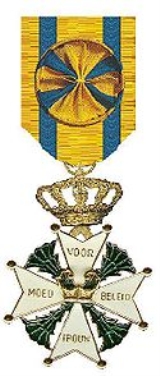
Order of William
Encyclopedia
The Military William Order, or often named Military Order of William (Dutch
: Militaire Willems-Orde, abbreviation
: MWO), is the oldest and highest honour of the Kingdom of the Netherlands. The Order's motto is Voor Moed, Beleid en Trouw (For Bravery, Leadership
and Loyalty
). The chivalric order
was established on 30 April 1815 by King William I
and was presented for feats of excellent bravery on the battlefield and as a meritorious decoration to senior military officers. Comparable with the French Légion d’Honneur but far less awarded, the Military William Order is a chivalry order of merit open to everyone regardless of rank and nobility, and not only to Dutch military but also foreigners. To date the Order is extremely rarely awarded and only for excellent bravery in battle.
In the spring of 1940 it was decided that civilians would receive the Military Order of William for heroic acts in the resistance. The chancellor of the order and the government seem to have been unaware that the first civilian was awarded this order in 1815. After the liberation of the Netherlands and the Dutch East Indies
, several men and one woman from the resistance were awarded the Military Order of William.
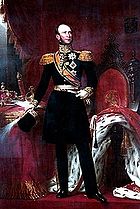 Most knighthoods of the Military Order of William were awarded in 1815 and shortly afterwards to military of the Allies that fought Napoleon at the Battle of Waterloo
Most knighthoods of the Military Order of William were awarded in 1815 and shortly afterwards to military of the Allies that fought Napoleon at the Battle of Waterloo
, in total over 1,000 knighthoods were awarded at this time. The Grand Cross was awarded to Prince William of Orange, the Duke of Wellington
, Fürst Blücher von Wahlstatt
, Graf von Bülow von Dennewitz
and Graf von Gneisenau
.
During the 19th century the Military William Order was awarded to military serving in the campaign against the Belgian Revolution
and military serving in the Netherlands East Indies, mostly in the Aceh War
. Until 1940, a total of 5,874 persons had been awarded the Military Order of William. In 1940, the Order was awarded to soldiers who had served with extreme valour in the defence of Netherlands from the 10 May attack by Nazi-Germany. In 1944 and 1945, with the liberation of the Netherlands from German occupation, the Military William Order was again awarded, this time to Netherlands citizens as well as members of the Allied Forces for deeds of gallantry. Of the 3,500 servicemen who served in the Netherlands United Nations Detachment in Korea, three servicemen – two posthumously – were admitted to the Order. Since 1940, 199 names have been added to the register of the Military Order of William. The latest conflict that has been cause for the honour to be awarded is the ongoing war in Afghanistan
.
The Grand Cross could also be awarded as an exceptional presentation to heads of state which had displayed feats of loyalty to The Netherlands during wartime. Only US President Franklin Delano Roosevelt, the British King George VI
and Queen Wilhelmina
of The Netherlands were conferred such an honour. In the 19th century, the Grand Cross was often conferred on foreign monarchs as a mere mark of respect.
The 4th Class could also be awarded as a unit presentation to military commands which had displayed feats of gallantry during wartime.
, in silver for the 4th Class and in gilt
for higher classes; a green enamelled Burgundy Cross appears between the arms of the Maltese Cross. The obverse bears a golden firesteel
at the centre, and the motto Voor Moed – Beleid – Trouw (For Bravery – Leadership – Loyalty) on the arms of the Maltese Cross. Both the Burgundy Cross and the firesteel were symbols of the House of Valois-Burgundy
and probably are meant to recall it crucial role in the history of the Netherland. The reverse central disc bears a crowned monogram "W" (for King William I
) surrounded by a laurel wreath. The badge hangs from a royal crown.
The star of the Grand Cross is a silver, 8-pointed star with straight rays; the obverse of the badge of the Order, minus the crown, appears at its centre.
The breast cross of the Commander is completely identical to the obverse of the badge of the Order.
The ribbon of the Order is orange (Royal House of Orange) with blue (Nassau-blue) stripes near the border.
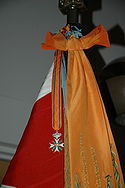 To be awarded the Military William Order a military unit must distinguish itself in battle to such a degree as would warrant the personal presentation of the Military William Order. The unit's Regimental Colour
To be awarded the Military William Order a military unit must distinguish itself in battle to such a degree as would warrant the personal presentation of the Military William Order. The unit's Regimental Colour
are decorated with the badge of the 4th Class itself, which hangs from the finial of the pike. The version of the Military William Order for unit members is known as the Orange Lanyard. Only those who served in a military unit at the particular time of action are entitled to wear the Orange Lanyard.
The Orange Lanyard
is worn as a cord around the right shoulder and can be worn simultaneously with the French or Belgian Fourragère of the Croix de guerre
. The Orange Lanyard is considered a permanent decoration and is worn for the duration of a military member's career.
Six elements of the Netherlands armed forces were decorated as a consequence of their actions during the Second World War: the Naval Air Arm of the Royal Netherlands Navy
; the Submarine Service of the Royal Netherlands Navy; the Marine Corps of the Royal Netherlands Navy; the Royal Netherlands 'Prinses Irene' Brigade, whose traditions are continued by the 'Prinses Irene' Fusilier Guards Regiment
; the Military Air Arm in the Netherlands and the Military Air Arm of the Royal Netherlands Indies Army, whose traditions both are continued by the Royal Netherlands Air Force
. Since 1972, the Military Order of William has been part of the colours of the 'Van Heutz'
Regiment of the Royal Netherlands Army
. This regiment continues the traditions of the Royal Netherlands Indies Army
KNIL. Three KNIL units, namely the 7th Field Battalion, the 3rd Field Battalion and the Marechaussee Corps of Aceh and Dependencies were awarded the Military William Order in 1849, 1877 and 1930 respectively.
Two foreign military units have received the Military William Order:
, Platoon Commander with the Korps Commandotroepen
, with the rank of Knight in the Military William Order 4th class for conspicuous bravery, leadership and devotion to duty. He was honoured for service his in Afghanistan from March to August 2006.
Dutch language
Dutch is a West Germanic language and the native language of the majority of the population of the Netherlands, Belgium, and Suriname, the three member states of the Dutch Language Union. Most speakers live in the European Union, where it is a first language for about 23 million and a second...
: Militaire Willems-Orde, abbreviation
Abbreviation
An abbreviation is a shortened form of a word or phrase. Usually, but not always, it consists of a letter or group of letters taken from the word or phrase...
: MWO), is the oldest and highest honour of the Kingdom of the Netherlands. The Order's motto is Voor Moed, Beleid en Trouw (For Bravery, Leadership
Leadership
Leadership has been described as the “process of social influence in which one person can enlist the aid and support of others in the accomplishment of a common task". Other in-depth definitions of leadership have also emerged.-Theories:...
and Loyalty
Loyalty
Loyalty is faithfulness or a devotion to a person, country, group, or cause There are many aspects to...
). The chivalric order
Order (decoration)
An order or order of merit is a visible honour, awarded by a government, dynastic house or international organization to an individual, usually in recognition of distinguished service to a nation or to humanity. The distinction between orders and decorations is somewhat vague, except that most...
was established on 30 April 1815 by King William I
William I of the Netherlands
William I Frederick, born Willem Frederik Prins van Oranje-Nassau , was a Prince of Orange and the first King of the Netherlands and Grand Duke of Luxembourg....
and was presented for feats of excellent bravery on the battlefield and as a meritorious decoration to senior military officers. Comparable with the French Légion d’Honneur but far less awarded, the Military William Order is a chivalry order of merit open to everyone regardless of rank and nobility, and not only to Dutch military but also foreigners. To date the Order is extremely rarely awarded and only for excellent bravery in battle.
In the spring of 1940 it was decided that civilians would receive the Military Order of William for heroic acts in the resistance. The chancellor of the order and the government seem to have been unaware that the first civilian was awarded this order in 1815. After the liberation of the Netherlands and the Dutch East Indies
Dutch East Indies
The Dutch East Indies was a Dutch colony that became modern Indonesia following World War II. It was formed from the nationalised colonies of the Dutch East India Company, which came under the administration of the Netherlands government in 1800....
, several men and one woman from the resistance were awarded the Military Order of William.
History

Battle of Waterloo
The Battle of Waterloo was fought on Sunday 18 June 1815 near Waterloo in present-day Belgium, then part of the United Kingdom of the Netherlands...
, in total over 1,000 knighthoods were awarded at this time. The Grand Cross was awarded to Prince William of Orange, the Duke of Wellington
Arthur Wellesley, 1st Duke of Wellington
Field Marshal Arthur Wellesley, 1st Duke of Wellington, KG, GCB, GCH, PC, FRS , was an Irish-born British soldier and statesman, and one of the leading military and political figures of the 19th century...
, Fürst Blücher von Wahlstatt
Gebhard Leberecht von Blücher
Gebhard Leberecht von Blücher, Fürst von Wahlstatt , Graf , later elevated to Fürst von Wahlstatt, was a Prussian Generalfeldmarschall who led his army against Napoleon I at the Battle of the Nations at Leipzig in 1813 and at the Battle of Waterloo in 1815 with the Duke of Wellington.He is...
, Graf von Bülow von Dennewitz
Friedrich Wilhelm Freiherr von Bülow
Friedrich Wilhelm Freiherr von Bülow, Graf von Dennewitz was a Prussian general of the Napoleonic Wars.-Early life:...
and Graf von Gneisenau
August von Gneisenau
August Wilhelm Antonius Graf Neidhardt von Gneisenau was a Prussian field marshal. He was a prominent figure in the reform of the Prussian military and the War of Liberation.-Early life:...
.
During the 19th century the Military William Order was awarded to military serving in the campaign against the Belgian Revolution
Belgian Revolution
The Belgian Revolution was the conflict which led to the secession of the Southern provinces from the United Kingdom of the Netherlands and established an independent Kingdom of Belgium....
and military serving in the Netherlands East Indies, mostly in the Aceh War
Aceh War
The Aceh War, also known as the Dutch War or the Infidel War , was an armed military conflict between the Sultanate of Aceh and the Netherlands which was triggered by discussions between representatives of Aceh and the U.S. in Singapore during early 1873...
. Until 1940, a total of 5,874 persons had been awarded the Military Order of William. In 1940, the Order was awarded to soldiers who had served with extreme valour in the defence of Netherlands from the 10 May attack by Nazi-Germany. In 1944 and 1945, with the liberation of the Netherlands from German occupation, the Military William Order was again awarded, this time to Netherlands citizens as well as members of the Allied Forces for deeds of gallantry. Of the 3,500 servicemen who served in the Netherlands United Nations Detachment in Korea, three servicemen – two posthumously – were admitted to the Order. Since 1940, 199 names have been added to the register of the Military Order of William. The latest conflict that has been cause for the honour to be awarded is the ongoing war in Afghanistan
War in Afghanistan (2001–present)
The War in Afghanistan began on October 7, 2001, as the armed forces of the United States of America, the United Kingdom, Australia, and the Afghan United Front launched Operation Enduring Freedom...
.
Grades
By 1945, the following classes of the Military William Order were in existence.- Knight 1st Class or Grand Cross – wears the badge on a sash on the right shoulder, plus the star on the left chest;
- Knight 2nd Class or Commander – wears the badge on a necklet, plus an identical breast cross on the left chest;
- Knight 3rd Class or Officer – wears the badge on a ribbon with rosetteRosette (decoration)A rosette is a small, circular device that is presented with a medal. The rosettes are primarily for situations where wearing the medal is deemed inappropriate. Rosettes are issued in nations such as France, Italy and Japan...
on the left chest; - Knight 4th Class or Knight – wears the badge on a ribbon on the left chest.
The Grand Cross could also be awarded as an exceptional presentation to heads of state which had displayed feats of loyalty to The Netherlands during wartime. Only US President Franklin Delano Roosevelt, the British King George VI
George VI of the United Kingdom
George VI was King of the United Kingdom and the Dominions of the British Commonwealth from 11 December 1936 until his death...
and Queen Wilhelmina
Wilhelmina of the Netherlands
Wilhelmina was Queen regnant of the Kingdom of the Netherlands from 1890 to 1948. She ruled the Netherlands for fifty-eight years, longer than any other Dutch monarch. Her reign saw World War I and World War II, the economic crisis of 1933, and the decline of the Netherlands as a major colonial...
of The Netherlands were conferred such an honour. In the 19th century, the Grand Cross was often conferred on foreign monarchs as a mere mark of respect.
The 4th Class could also be awarded as a unit presentation to military commands which had displayed feats of gallantry during wartime.
| Knight Grand Cross (badge with sash and accompanying star) |
Knight Commander (badge with necklet and breast cross) |
Knight Officer (badge with ribbon) |
Knight 4th Class (Badge with ribbon) |
|---|---|---|---|
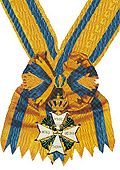  |
 |
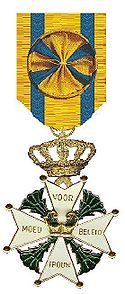 |
 |
Insignia
The badge of the Order is a white-enamelled Maltese CrossMaltese cross
The Maltese cross, also known as the Amalfi cross, is identified as the symbol of an order of Christian warriors known as the Knights Hospitaller or Knights of Malta and through them came to be identified with the Mediterranean island of Malta and is one of the National symbols of Malta...
, in silver for the 4th Class and in gilt
Gilding
The term gilding covers a number of decorative techniques for applying fine gold leaf or powder to solid surfaces such as wood, stone, or metal to give a thin coating of gold. A gilded object is described as "gilt"...
for higher classes; a green enamelled Burgundy Cross appears between the arms of the Maltese Cross. The obverse bears a golden firesteel
Firesteel
A Fire striker is a piece of high-carbon steel used for striking a spark, usually kept in a tinderbox together with flint and tinder.-Usage:...
at the centre, and the motto Voor Moed – Beleid – Trouw (For Bravery – Leadership – Loyalty) on the arms of the Maltese Cross. Both the Burgundy Cross and the firesteel were symbols of the House of Valois-Burgundy
House of Valois-Burgundy
The term "Valois Dukes of Burgundy" is employed to refer to the dynasty which began after John II of France granted the Duchy of Burgundy to his youngest son, Philip the Bold...
and probably are meant to recall it crucial role in the history of the Netherland. The reverse central disc bears a crowned monogram "W" (for King William I
William I of the Netherlands
William I Frederick, born Willem Frederik Prins van Oranje-Nassau , was a Prince of Orange and the first King of the Netherlands and Grand Duke of Luxembourg....
) surrounded by a laurel wreath. The badge hangs from a royal crown.
The star of the Grand Cross is a silver, 8-pointed star with straight rays; the obverse of the badge of the Order, minus the crown, appears at its centre.
The breast cross of the Commander is completely identical to the obverse of the badge of the Order.
The ribbon of the Order is orange (Royal House of Orange) with blue (Nassau-blue) stripes near the border.
Knighthood oath
The oath to be taken by the accolade to the Military Order of William states: “ I swear that I shall conduct myself as a faithful and valiant Knight, to stand ever ready to defend King and Country with my Life, and with all my Powers to always strive to be worthy of this Distinction, which the King has bestowed upon me. So help me God almighty.”Unit award

Colours, standards and guidons
In military organizations, the practice of carrying colours, standards or Guidons, both to act as a rallying point for troops and to mark the location of the commander, is thought to have originated in Ancient Egypt some 5,000 years ago...
are decorated with the badge of the 4th Class itself, which hangs from the finial of the pike. The version of the Military William Order for unit members is known as the Orange Lanyard. Only those who served in a military unit at the particular time of action are entitled to wear the Orange Lanyard.
The Orange Lanyard
Lanyard
A lanyard is a rope or cord exclusively worn around the neck or wrist to carry something. Usually it is used where there is a risk of losing the object or to ensure it is visible at all times. Aboard a ship, it may refer to a piece of rigging used to secure objects...
is worn as a cord around the right shoulder and can be worn simultaneously with the French or Belgian Fourragère of the Croix de guerre
Croix de guerre
The Croix de guerre is a military decoration of France. It was first created in 1915 and consists of a square-cross medal on two crossed swords, hanging from a ribbon with various degree pins. The decoration was awarded during World War I, again in World War II, and in other conflicts...
. The Orange Lanyard is considered a permanent decoration and is worn for the duration of a military member's career.
Six elements of the Netherlands armed forces were decorated as a consequence of their actions during the Second World War: the Naval Air Arm of the Royal Netherlands Navy
Royal Netherlands Navy
The Koninklijke Marine is the navy of the Netherlands. In the mid-17th century the Dutch Navy was the most powerful navy in the world and it played an active role in the wars of the Dutch Republic and later those of the Batavian Republic and the Kingdom of the Netherlands...
; the Submarine Service of the Royal Netherlands Navy; the Marine Corps of the Royal Netherlands Navy; the Royal Netherlands 'Prinses Irene' Brigade, whose traditions are continued by the 'Prinses Irene' Fusilier Guards Regiment
Garderegiment Fuseliers Prinses Irene
The Garderegiment Fuseliers Prinses Irene is a regiment of the Royal Netherlands Army, named after Princess Irene, the sister of Queen Beatrix. It is one of two regiments, along with the Garderegiment Grenadiers en Jagers, to be classed as 'Guards'...
; the Military Air Arm in the Netherlands and the Military Air Arm of the Royal Netherlands Indies Army, whose traditions both are continued by the Royal Netherlands Air Force
Royal Netherlands Air Force
The Royal Netherlands Air Force , Dutch Koninklijke Luchtmacht , is the military aviation branch of the Netherlands Armed Forces. Its ancestor, the Luchtvaartafdeling of the Dutch Army was founded on 1 July 1913, with four pilots...
. Since 1972, the Military Order of William has been part of the colours of the 'Van Heutz'
Regiment Van Heutsz
The Regiment Van Heutsz is a line infantry regiment of the Royal Netherlands Army. The regiment was named after J.B. van Heutsz a former Governor-General of the Dutch East Indies, and was formed on July 1, 1950. It currently, in 2011, operates as 12 Air Assault Infantry Battalion as part of 11...
Regiment of the Royal Netherlands Army
Royal Netherlands Army
The Royal Netherlands Army is the land forces element of the military of the Netherlands.-Short history:The Royal Netherlands Army was raised on 9 January 1814, but its origins date back to 1572, when the so-called Staatse Leger was raised...
. This regiment continues the traditions of the Royal Netherlands Indies Army
Royal Netherlands East Indies Army
The Royal Netherlands East Indies Army was the military force maintained by the Netherlands in its colony of the Netherlands East Indies . The KNIL's air arm was the Royal Netherlands East Indies Army Air Force...
KNIL. Three KNIL units, namely the 7th Field Battalion, the 3rd Field Battalion and the Marechaussee Corps of Aceh and Dependencies were awarded the Military William Order in 1849, 1877 and 1930 respectively.
Two foreign military units have received the Military William Order:
- The U.S. 82nd Airborne DivisionU.S. 82nd Airborne DivisionThe 82nd Airborne Division is an active airborne infantry division of the United States Army specializing in parachute landing operations. Based at Fort Bragg, North Carolina, the 82nd Airborne Division is the primary fighting arm of the XVIII Airborne Corps....
for gallantry during Operation Market GardenOperation Market GardenOperation Market Garden was an unsuccessful Allied military operation, fought in the Netherlands and Germany in the Second World War. It was the largest airborne operation up to that time....
in 1944; - The Polish 1st Independent Parachute BrigadePolish 1st Independent Parachute BrigadeThe 1st Independent Parachute Brigade was a parachute brigade under command of Maj.Gen. Stanisław Sosabowski, created in Scotland in September 1941, with the exclusive mission to drop into occupied Poland in order to help liberate the country. The British government, however, pressured the Polish...
for gallantry at the Battle of ArnhemBattle of ArnhemThe Battle of Arnhem was a famous Second World War military engagement fought in and around the Dutch towns of Arnhem, Oosterbeek, Wolfheze, Driel and the surrounding countryside from 17–26 September 1944....
, during Operation Market GardenOperation Market GardenOperation Market Garden was an unsuccessful Allied military operation, fought in the Netherlands and Germany in the Second World War. It was the largest airborne operation up to that time....
in 1944 (awarded in May 2006).
Current living members of the Order
Below a list of the names of the still living knights, in chronologic order and with between brackets the date when they were inducted into the Order:- Capt. Frits Jan Willem den Ouden (12 February 1942): Maj. Kenneth G. Mayhew (24 April 1946): Lt. Edward Simons FulmerEdward Simons FulmerEdward Simons Fulmer is a former officer and pilot of the United States Army Air Forces. Fulmer is one of the few living Knights of the Military William Order.-Military career:...
(17 October 1946): Cpl. Albert Hoeben (28 May 1947): Cornelis Pieter van den Hoek (30 August 1948): Lt Col. Pierre Louis, Baron d’Aulnis de Bourouill (7 January 1950): Lt. Giovanni Narcis Hakkenberg (6 March 1951): Capt. Marco KroonMarco KroonCaptain Marinus Johannes "Marco" Kroon, RMWO is a Dutch soldier serving with the Korps Commandotroepen. Kroon is a Knight of the Military William Order and the first new member of this very exclusive Order in over half a century...
(29 May 2009)
The Military William Order in the 21st century
As of 2011, only eight Knights of the Military William Order are still alive, seven of which are over 85 years of age. The last ceremony where the Knights met was on 29 May 2009 at the Binnenhof, in The Hague, when Her Majesty Queen Beatrix bestowed Marco KroonMarco Kroon
Captain Marinus Johannes "Marco" Kroon, RMWO is a Dutch soldier serving with the Korps Commandotroepen. Kroon is a Knight of the Military William Order and the first new member of this very exclusive Order in over half a century...
, Platoon Commander with the Korps Commandotroepen
Korps Commandotroepen
The Korps Commandotroepen are the elite special forces of the Royal Netherlands Army. It is one of the two principal units tasked with special operations in the Netherlands , and it is deployable anywhere in the world under any circumstance, conducting all conceivable missions from...
, with the rank of Knight in the Military William Order 4th class for conspicuous bravery, leadership and devotion to duty. He was honoured for service his in Afghanistan from March to August 2006.
Privileges
Members of the Military William Order are awarded certain privileges:- When wearing the decorations, a member must be saluted by all Dutch military personnel regardless of rank or branch.
- Once a year all members of the Order are invited to the palaceNoordeinde PalaceNoordeinde Palace is one of the three official palaces of the Dutch royal family. Located in The Hague in the province of South Holland, it has been used as the "working palace" for Queen Beatrix since 1984.-From farmhouse to palace:...
by the monarch on the so-called Ridderdag (Knights day). - Individual members of the Order are granted an annual pension by the Dutch state
- Members of the Order are granted VIPVIPVIP and V.I.P. is a three-letter acronym that may refer to:-In general:* Vacuum insulated panel* Values, Influence, and Peers, an anti-crime campaign in Ontario elementary schools* Variable Information Printing, a form of on-demand printing...
seats during military ceremonies, the annual address of parliament by the monarchPrinsjesdagPrinsjesdag is the day on which the reigning monarch of the Netherlands addresses a joint session of the Dutch Senate and House of Representatives in the Ridderzaal or Hall of Knights in The Hague. The Speech from the Throne sets out the main features of government policy for the coming...
and during state funerals.
External links
See also
- Order of the Netherlands Lion
- Order of Orange Nassau
- Dutch Cross of ResistanceDutch Cross of ResistanceThe Verzetskruis 1940–1945 is one of the highest possible decorations that exist within the Kingdom of the Netherlands....

